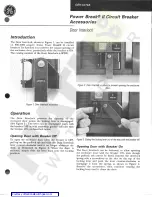
IB 6.2.11.1-2C
Page 4
ABB
Circuit Breaker Nameplates (Figure 1, Item 4).
The
circuit breaker nameplates contain information
regarding the manufacturer's name and address, type
of circuit breaker design, serial number of circuit
breaker, continuous current rating of frame size, short
circuit current rating at rated voltages, frequency, short
time current, and breaker control voltages.
Manual Charging Handle (Figure 1, Item 16).
The
manual charging handle is a T-shaped lever used to
charge the closing springs by pumping approximately
ten times.
Manual Trip Button (Figure 1, Item 10).
The manual
trip button, when pushed, trips the circuit breaker to
"OPEN."
Circuit Breaker "OPEN" or "CLOSED" Indicator
(Figure 1, Item 2).
This indicator shows the physical
position of the circuit breaker contacts.
Automatic Trip Indicator (Figure 1, Item 15).
(Not
including undervoltage, alarm switch, or lockout). The
automatic trip indicator is provided as standard
equipment on the K-Line Plus circuit breakers and is
used to indicate the operation of the overcurrent trip
device. This device is an indicator only and does not
prevent the circuit breaker from reclosing.
Upon an overcurrent trip operation, the indicator
protrudes from the front plate approximately 1/2 inch.
The automatic trip indicator should be reset after each
trip indication by pushing it back into its normal latch
position. The operator should investigate the cause of
tripping before resetting the automatic trip indicator and
subsequently reclosing the circuit breaker after an
outage which results in an operation of the indicator.
Automatic Trip Alarm Contacts (optional - not
shown).
An alarm switch for remote electrical
indication, which is optional, shows when automatic
tripping has occurred. This is accomplished by adding
a precision snap switch to the automatic trip indicator
assembly. The automatic trip indicator actuates the
roller on the alarm switch which in turn causes a
normally open contact to close and a normally closed
contact to open on overcurrent trip. The alarm contact
is manually reset by pushing the trip indicator back into
its normal position.
Automatic Trip Lockout (optional - not shown).
An
additional optional device may be added to the
automatic trip indicator assembly device which serves
to mechanically prevent reclosing the circuit breaker
after an automatic trip operation. When the trip
indicator is pushed in, the circuit breaker mechanism
can then be operated to close the circuit breaker
contacts.
Padlocking Device (Figure 1, Item 13).
All K-Line
Plus circuit breakers are equipped with means of
padlocking the circuit breaker mechanism in a trip-tree
position. This is accomplished by the use of a locking
plate to maintain the manual trip button in a tripping
direction when the locking plate is held forward by one
or more padlocks. To obtain the condition for
padlocking the circuit breaker in the open position, the
manual trip button is pushed inward. Then the padlock
plate is pulled out and the padlock inserted into the
vertical slot. In this position, the mechanism is
maintained trip free and the contacts cannot be moved
to the closed position.
The padlocking device is also associated with the
drawout interlocking mechanism so that the circuit
breaker cannot be moved from any of its three basic
drawout positions of "CONNECTED", “TEST” or
"DISCONNECTED" with the padlocking in effect.
Closing Spring Charge Indicator (Figure 1, Item 6).
Under normal operating conditions, the closing springs
of an electrically operated breaker are automatically
charged after each tripping operation. However, there
are occasions when the springs will be in a discharged
state. Therefore, it is desirable that means be available
to indicate the condition of the closing springs. This is
accomplished by a visual indicator seen through an
aperture in the escutcheon plate. The indicator is
marked "CHARGED" and "UNCHARGED."
Motor Disconnect Switch (Figure 1, Item 14).
The
motor disconnect switch (EO breakers only) is a double
pole, single-throw toggle type switch connected in
series with the charging motor circuit and is used to
disconnect the motor from the voltage source. This
switch is used: (a) when it is desirable to prevent
automatic recharging of the closing springs just prior to
taking the circuit breaker out of service for
maintenance, and (b) for control wiring dielectric test.
The motor must be disconnected for the control wiring
dielectric test and subsequently tested at the
appropriate voltage.
Electrical Close and Trip Push Buttons (Optional,
Figure 1, Item 20).
The electrical close and trip push
buttons are used to electrically operate the circuit
breaker from the escutcheon. These contacts are
connected in series with their respective latch release
coils. Energizing the close latch release coil allows the
charged springs to close the circuit breaker, while
energizing the trip latch release coil allows the breaker
to open.
(Continued on page 8)
Содержание K-Line Plus KP-32
Страница 20: ...IB 6 2 11 1 2C Page 20 ABB NOTES ...
Страница 21: ...IB 6 2 11 1 2C Page 21 ABB NOTES ...






























